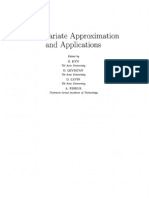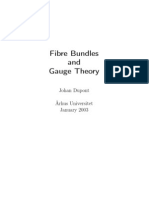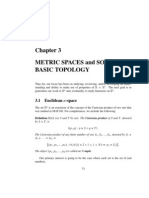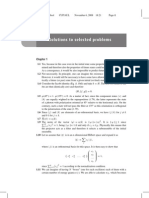0 ratings0% found this document useful (0 votes)
184 viewsTopología General - Willard
Topología General - Willard
Uploaded by
siennaThis document discusses several topics in topology:
1. It provides 5 examples of topological spaces, including the collection of closed bounded subsets of the real numbers, and topologies generated by subsets of a space X.
2. It states that any closed subset of the plane R2 is the frontier of some set in R2.
3. It notes that the maximum number of sets that can be generated by complementation and closure operations on a subset of a topological space is 14, and this can be achieved by a subset of the real numbers.
4. It defines regularly open and regularly closed sets and lists some of their properties, including that the complement of a regularly open set is regularly closed and vice versa.
Copyright:
© All Rights Reserved
Available Formats
Download as PDF, TXT or read online from Scribd
Topología General - Willard
Topología General - Willard
Uploaded by
sienna0 ratings0% found this document useful (0 votes)
184 views380 pagesThis document discusses several topics in topology:
1. It provides 5 examples of topological spaces, including the collection of closed bounded subsets of the real numbers, and topologies generated by subsets of a space X.
2. It states that any closed subset of the plane R2 is the frontier of some set in R2.
3. It notes that the maximum number of sets that can be generated by complementation and closure operations on a subset of a topological space is 14, and this can be achieved by a subset of the real numbers.
4. It defines regularly open and regularly closed sets and lists some of their properties, including that the complement of a regularly open set is regularly closed and vice versa.
Copyright
© © All Rights Reserved
Available Formats
PDF, TXT or read online from Scribd
Share this document
Did you find this document useful?
Is this content inappropriate?
This document discusses several topics in topology:
1. It provides 5 examples of topological spaces, including the collection of closed bounded subsets of the real numbers, and topologies generated by subsets of a space X.
2. It states that any closed subset of the plane R2 is the frontier of some set in R2.
3. It notes that the maximum number of sets that can be generated by complementation and closure operations on a subset of a topological space is 14, and this can be achieved by a subset of the real numbers.
4. It defines regularly open and regularly closed sets and lists some of their properties, including that the complement of a regularly open set is regularly closed and vice versa.
Copyright:
© All Rights Reserved
Available Formats
Download as PDF, TXT or read online from Scribd
Download as pdf or txt
0 ratings0% found this document useful (0 votes)
184 views380 pagesTopología General - Willard
Topología General - Willard
Uploaded by
siennaThis document discusses several topics in topology:
1. It provides 5 examples of topological spaces, including the collection of closed bounded subsets of the real numbers, and topologies generated by subsets of a space X.
2. It states that any closed subset of the plane R2 is the frontier of some set in R2.
3. It notes that the maximum number of sets that can be generated by complementation and closure operations on a subset of a topological space is 14, and this can be achieved by a subset of the real numbers.
4. It defines regularly open and regularly closed sets and lists some of their properties, including that the complement of a regularly open set is regularly closed and vice versa.
Copyright:
© All Rights Reserved
Available Formats
Download as PDF, TXT or read online from Scribd
Download as pdf or txt
You are on page 1of 380
At a glance
Powered by AI
The text discusses different types of topologies and topological concepts like closure, interior, regularly open and closed sets.
Some examples of topologies mentioned are the collection of closed bounded subsets of R together with R itself, the family of subsets containing a fixed set A, and the radial topology on R^2.
A regularly open set is the interior of its closure, while a regularly closed set is the closure of its interior. The complement of a regularly open set is regularly closed and vice versa.
3) Problems 29
Problema
3A. Examples of topologies
l . If !F is the' collection of all closed, bounded subsets of R (in its usual topology1 to
gether withR itse)t then !F is the family of closed sets for a topology onR strictly weaker than
the usual topology.
2. If A e X, show that the family of ali subsets of X which contain A, together with the
empty set 0, is a topology on X. Describe the closure and interior operations. What topology
results when A = 0? when A = X?
3. Let B be a fuced subset of X and for each nonempty A e X, Jet A = A v B, with
0 = 0. Verify that A -+ A is a closure operation. Describe the open sets in the resulting
topology. What topology results when B = 0? when B = X?
4. Call a subset ofR 2 radially open iff it contains an open line segment in each direction
about each of its points. Show that the collection of radially open sets is a topology forR 2.
Compare this topology with the usual topology on R2 (ie., is it weaker, stronger, the same
or none of these?). Toe plane with t�is topology will be called the radial plane.
S. If A e X and T is any topology for X, then { U v (V r'I A) 1 U, V e T} is a topology
for X. It is called the simple extension of T over A.
3B. Frontiers in the p/ane
Any closed subset of the plane R2 is the frontier of sorne set in R 2 .
3C. ' Complementation and closure
lf A is any subset of a topological space, the largest possible number of different sets in the two
seque�ces
A, A', A'-, A'-', .. .
A, A-, A-,, A_,-, . . .
(where' denotes complementation and - denotes closure) is 14. There is a subset ofR which
gives 14. [For any open set G, CI (Int (CI G)) = CI G.J
3D. Regular/y open and regular/y c/osed sets
An open subset G in a topological space is regular/y open iff G is the interior of its closure. A
closed subset is regular/y closed iff it is the closure of its interior.
l . Toe complement of a regularly open set is regularly closed and vice versa.
2. There are open sets inR wbich are not regularly open.
3. If A is any subset of a topological space, then lnt (CI (A)) is regularly open.
.
4. Toe intersection, but not necessarily the union, of two regularly open sets is regularly
open. (Thus the same proposition, with "union" and "intersection" interchanged, holds for
regularly closed sets.)
You might also like
- Tomkowicz G., Wagon S. - The Banach-Tarski ParadoxDocument366 pagesTomkowicz G., Wagon S. - The Banach-Tarski ParadoxMad_TricksterNo ratings yet
- Lee J.M. Introduction To Smooth Manifolds - Errata PDFDocument7 pagesLee J.M. Introduction To Smooth Manifolds - Errata PDFPetr IvankovNo ratings yet
- Math 139 Fourier Analysis Notes PDFDocument212 pagesMath 139 Fourier Analysis Notes PDFAidan HolwerdaNo ratings yet
- A Panoramic View of Riemannian GeometryDocument872 pagesA Panoramic View of Riemannian Geometryedwww100% (3)
- (Springer Monographs in Mathematics) Jean-Pierre Serre - Local Algebra (2000, Springer) PDFDocument143 pages(Springer Monographs in Mathematics) Jean-Pierre Serre - Local Algebra (2000, Springer) PDFLudwig WittgensteinNo ratings yet
- Introduction To General Relativity - G. T.hooftDocument68 pagesIntroduction To General Relativity - G. T.hooftmostafa-tallat70No ratings yet
- Differential Geometry 2009-2010Document45 pagesDifferential Geometry 2009-2010Eric ParkerNo ratings yet
- Multivariate ApproximationDocument296 pagesMultivariate ApproximationAlexander Golikov100% (1)
- Introduction To General TopologyDocument62 pagesIntroduction To General TopologyLe Duy HienNo ratings yet
- Ca09 Catalog Web PDFDocument15 pagesCa09 Catalog Web PDFSharan RathodNo ratings yet
- Theory of Finite GroupsDocument254 pagesTheory of Finite Groupsteesri_aankhNo ratings yet
- ModulesDocument10 pagesModulesKanchit SaehoNo ratings yet
- Hirsch SmaleDocument186 pagesHirsch SmaleJulioCesarMohnsamNo ratings yet
- Classification of One ManifoldsDocument7 pagesClassification of One ManifoldslordpersonNo ratings yet
- Tao An Epsilon of RoomDocument689 pagesTao An Epsilon of RoomMichael Raba100% (1)
- ALL SPACETIMES BEYOND EINSTEIN by Frederic P. SchullerDocument44 pagesALL SPACETIMES BEYOND EINSTEIN by Frederic P. SchullerHassan FawazNo ratings yet
- Differential TopologyDocument74 pagesDifferential TopologyYuang ShiNo ratings yet
- Krebs M., Shaheen A. Expander Families and Cayley Graphs. A Beginner's GuideDocument283 pagesKrebs M., Shaheen A. Expander Families and Cayley Graphs. A Beginner's GuideIustin Surubaru100% (1)
- Gtm150 Commutative Algebra Solutions-2Document33 pagesGtm150 Commutative Algebra Solutions-2Jack HongNo ratings yet
- Selected Solutions To Dummit and Foote's Abstract Algebra Third EditionDocument157 pagesSelected Solutions To Dummit and Foote's Abstract Algebra Third EditionVale VanegasNo ratings yet
- Jacob Palis JR., Welington de Melo (Auth.) - Geometric Theory of Dynamical Systems - An Introduction-Springer US (1982)Document207 pagesJacob Palis JR., Welington de Melo (Auth.) - Geometric Theory of Dynamical Systems - An Introduction-Springer US (1982)Jhony Sandoval Juarez100% (1)
- Kaplansky Commutative RingsDocument96 pagesKaplansky Commutative Ringsperezm7100% (3)
- (London Mathematical Society Lecture Note Series 44) M. C. Crabb - ZZ - 2, Homotopy Theory (1980, Cambridge University Press)Document135 pages(London Mathematical Society Lecture Note Series 44) M. C. Crabb - ZZ - 2, Homotopy Theory (1980, Cambridge University Press)Luis Arce GonzálezNo ratings yet
- Differentiable ManifoldsDocument94 pagesDifferentiable Manifoldszcapg17No ratings yet
- Jech Set Theory Solutions KindleDocument29 pagesJech Set Theory Solutions KindleDanny Estefany Paz VidalNo ratings yet
- Dupont - Fiber Bundles in Gauge TheoryDocument109 pagesDupont - Fiber Bundles in Gauge TheoryWilfred HulsbergenNo ratings yet
- Ceccherini - Dadderio2021 - Topics in Groups and Geometry - Growth, Amenability, and Random WalksDocument468 pagesCeccherini - Dadderio2021 - Topics in Groups and Geometry - Growth, Amenability, and Random WalksRaimon ElguetaNo ratings yet
- Surv138 Endmatter PDFDocument41 pagesSurv138 Endmatter PDFRajesh Shahi100% (1)
- Real AnalysisDocument7 pagesReal AnalysisJose Luis CondoriNo ratings yet
- 4 Pioneers of Representation Theory Frobenius Burnside Schur and BrauerDocument312 pages4 Pioneers of Representation Theory Frobenius Burnside Schur and BrauerBeatriz Moreno LópezNo ratings yet
- Complex Rnnivsis and Appucrtions: NG - Shengjian Wu Jasi Wulan - LoyangDocument349 pagesComplex Rnnivsis and Appucrtions: NG - Shengjian Wu Jasi Wulan - Loyangnelsondiezgarcia100% (2)
- Cyclotomic PolynomialsDocument13 pagesCyclotomic PolynomialsPh HuyamNo ratings yet
- Masayoshi Nagata-Local Rings (Tracts in Pure & Applied Mathematics) - John Wiley & Sons Inc (1962) PDFDocument248 pagesMasayoshi Nagata-Local Rings (Tracts in Pure & Applied Mathematics) - John Wiley & Sons Inc (1962) PDFFabio Arevalo100% (4)
- Topologia - Novikov PDFDocument321 pagesTopologia - Novikov PDFJimmy Bomfim de Jesus100% (1)
- Devinatz D. - Advanced Calculus (1963)Document496 pagesDevinatz D. - Advanced Calculus (1963)shareef100% (5)
- A First Course in Functional Analysis Theory and ApplicationsDocument487 pagesA First Course in Functional Analysis Theory and Applicationsسعدالدين مالك الرفاعي عبدالرحمن100% (2)
- Galois Theory For SchemesDocument113 pagesGalois Theory For Schemesกานดิศ คำกรุNo ratings yet
- Measure and IntegrationDocument417 pagesMeasure and IntegrationAparna GuhaNo ratings yet
- Differentiable ManifoldsDocument132 pagesDifferentiable ManifoldsPEDRO FLAVIO SILVA OTHECHARNo ratings yet
- (Masud Chaichian, Andrei Pavlovich Demichev) IntroDocument356 pages(Masud Chaichian, Andrei Pavlovich Demichev) IntroEmkafsNo ratings yet
- Hartshorne - Open ProblemsDocument12 pagesHartshorne - Open Problemscompul123No ratings yet
- Banach SpaceDocument13 pagesBanach SpaceAkselNo ratings yet
- Differentiable ManifoldDocument73 pagesDifferentiable ManifoldKirti Deo MishraNo ratings yet
- Discrete Groups, Expanding Graphs and Invariant Measures (A. Lubotzky) PDFDocument201 pagesDiscrete Groups, Expanding Graphs and Invariant Measures (A. Lubotzky) PDFbabazorm100% (1)
- Lie Algebras and Representation TheoryDocument102 pagesLie Algebras and Representation TheoryJulian Bravo100% (1)
- METRIC SPACES and SOME BASIC TOPOLOGYDocument50 pagesMETRIC SPACES and SOME BASIC TOPOLOGYhyd arnes100% (1)
- Alprintis Real Analysis SolDocument410 pagesAlprintis Real Analysis SolUzair ShahNo ratings yet
- Solutions To Selected Problems: K K K K N J J J JKDocument79 pagesSolutions To Selected Problems: K K K K N J J J JKdingo100% (2)
- Maxima and CalculusDocument52 pagesMaxima and CalculusPaulo HendlerNo ratings yet
- Complex ManifoldsDocument113 pagesComplex Manifoldskeynote76No ratings yet
- K - 3978 1 6333 7Document698 pagesK - 3978 1 6333 7李偉志No ratings yet
- N PDFDocument201 pagesN PDFKISHORE CHAKRABORTYNo ratings yet
- CompactnessDocument7 pagesCompactnessvamgaduNo ratings yet
- (Cambridge Series in Advanced Mathematics 65) A. J. Berrick, M. E. Keating - An Introduction To Rings and Modules With K-Theory in View (2000, Cambridge UnDocument284 pages(Cambridge Series in Advanced Mathematics 65) A. J. Berrick, M. E. Keating - An Introduction To Rings and Modules With K-Theory in View (2000, Cambridge UnAndres Naranjo100% (1)
- Color-Control of Long-Lasting Phosphorescence (LLP) Through Rare Earth Ion-Doped Cadmium Metasilicate PhosphorsDocument7 pagesColor-Control of Long-Lasting Phosphorescence (LLP) Through Rare Earth Ion-Doped Cadmium Metasilicate PhosphorsIlse Guadalupe EncinasNo ratings yet
- Factsheet NIFTY LargeMidcap 250 IndexDocument2 pagesFactsheet NIFTY LargeMidcap 250 IndexRahul RanjanNo ratings yet
- True Observing India 09 March 2024Document8 pagesTrue Observing India 09 March 2024raunakNo ratings yet
- Xylitol TechnologyDocument19 pagesXylitol TechnologyDIPAK VINAYAK SHIRBHATE100% (4)
- 2004 Ducati Multistrada MTS 1000DS Owner's ManualDocument102 pages2004 Ducati Multistrada MTS 1000DS Owner's ManualChristopheNo ratings yet
- Poerty AssignmentDocument5 pagesPoerty AssignmentJulie Marie BalabatNo ratings yet
- Injection Molding NotesDocument23 pagesInjection Molding NotesK_Amey50% (2)
- Don HenleyDocument5 pagesDon HenleyLisa Mielke100% (1)
- Questions On unit-III: What Is The Load Influence On Voltage SagsDocument1 pageQuestions On unit-III: What Is The Load Influence On Voltage SagsPavan KumarNo ratings yet
- Physics s5 TGDocument284 pagesPhysics s5 TGmpeaceishimweNo ratings yet
- (Schoenberg, 1950) Style and IdeaDocument117 pages(Schoenberg, 1950) Style and IdeaValerio Sebastiani100% (3)
- Transportation Models MBADocument25 pagesTransportation Models MBABabasab Patil (Karrisatte)No ratings yet
- Article 243682 1 10 20210909Document12 pagesArticle 243682 1 10 20210909Walter RodriguesNo ratings yet
- LPC2148 WatchdogtimerDocument10 pagesLPC2148 WatchdogtimerSania KawadeNo ratings yet
- The Journal of The Royal Society For The Promotion of Health-2004-Chamberlain-284-6Document4 pagesThe Journal of The Royal Society For The Promotion of Health-2004-Chamberlain-284-6mauricioelvis100% (1)
- Wiring of Fan Controlled by A Switch & Regulator: Experiment No. 3Document4 pagesWiring of Fan Controlled by A Switch & Regulator: Experiment No. 3ASHIK NNo ratings yet
- 8 KanbanDocument25 pages8 KanbanJabir AghadiNo ratings yet
- Working at Height PermitDocument1 pageWorking at Height PermitharikrishnaNo ratings yet
- Oort ConstantsDocument10 pagesOort Constantsnevelle4667No ratings yet
- Pratt Van Wigerden (2009) Nurs Care of Pt.s With TB (Schaaf Zumla - Tuberculosis (Chapter 69) XDocument7 pagesPratt Van Wigerden (2009) Nurs Care of Pt.s With TB (Schaaf Zumla - Tuberculosis (Chapter 69) XJelly JiaNo ratings yet
- Stress ManagementDocument61 pagesStress ManagementBura NareshNo ratings yet
- 6 2112100092 Abstract - EngDocument2 pages6 2112100092 Abstract - EngAqil AmmarNo ratings yet
- Ice Cream Pasteurizing Machine PASTOMASTER 60 RTXDocument42 pagesIce Cream Pasteurizing Machine PASTOMASTER 60 RTXKrissaline100% (1)
- Module 4 - Capacity PlanningDocument41 pagesModule 4 - Capacity PlanningMAYUR KARSADIYENo ratings yet
- Meteorology and ClimatolodyDocument7 pagesMeteorology and ClimatolodySylvia Sinda100% (1)
- Mathematics SBADocument15 pagesMathematics SBADeath ValleyNo ratings yet
- 13.70.0020 Clementia Caroline DAFTAR PUSTAKADocument3 pages13.70.0020 Clementia Caroline DAFTAR PUSTAKAfahrullah unhasNo ratings yet
- Pen Def and Types Per WikiDocument1 pagePen Def and Types Per Wikiglh00No ratings yet
- Aortic Root Size in Elite Athletes: EditorialDocument2 pagesAortic Root Size in Elite Athletes: EditorialCoen Coen WaruNo ratings yet
























































































